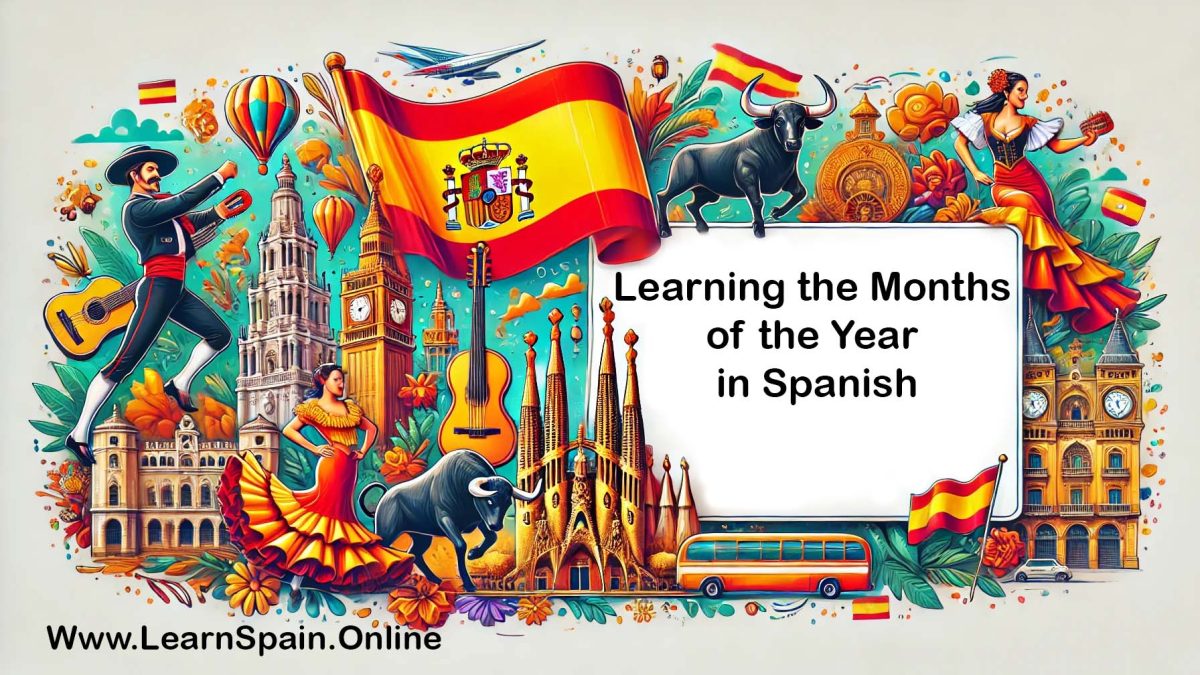
Learning the Days of the Week in Spanish
July 28, 2024
Learning Common Greetings in Spanish
July 28, 2024Learning the Months of the Year in Spanish
Understanding and being able to use the months of the year in Spanish vocabulary is essential for anyone learning the language. Whether you are scheduling appointments, planning events, or simply talking about dates, knowing the months in Spanish Grammar is crucial Learning Months and Year in Spanish. This comprehensive guide will cover the months of the year, provide examples, and help you understand their usage in different contexts. By the end of this article, you will be comfortable using Spanish months and able to incorporate them into your daily conversations.
The Months of the Year (Los Meses del Año)
Here are the months of the year in Spanish:
- Enero: January
- Febrero: February
- Marzo: March
- Abril: April
- Mayo: May
- Junio: June
- Julio: July
- Agosto: August
- Septiembre: September
- Octubre: October
- Noviembre: November
- Diciembre: December
Pronunciation Guide
Here’s a quick pronunciation guide to help you say these months correctly:
- Enero: eh-NEH-roh
- Febrero: feh-BREH-roh
- Marzo: MAR-soh
- Abril: ah-BREEL
- Mayo: MAH-yoh
- Junio: HOO-nee-oh
- Julio: HOO-lee-oh
- Agosto: ah-GOHS-toh
- Septiembre: sep-TYEHM-breh
- Octubre: ok-TOO-breh
- Noviembre: noh-VYEHM-breh
- Diciembre: dee-SYEHM-breh
Using the Months of the Year in Sentences
Knowing the vocabulary is just the first step. Here are some examples of how to use these words in sentences:
- Mi cumpleaños es en enero. (My birthday is in January.)
- Vamos de vacaciones en febrero. (We go on vacation in February.)
- La primavera empieza en marzo. (Spring starts in March.)
- El Día de los Trabajadores es en mayo. (Labor Day is in May.)
- El verano comienza en junio. (Summer starts in June.)
- El festival es en julio. (The festival is in July.)
- En agosto, hace mucho calor. (In August, it is very hot.)
- La escuela comienza en septiembre. (School starts in September.)
- Celebramos Halloween en octubre. (We celebrate Halloween in October.)
- El Día de Acción de Gracias es en noviembre. (Thanksgiving is in November.)
- La Navidad es en diciembre. (Christmas is in December.)
Describing Events and Activities by Month and Year in Spanish
Describing events and activities that occur in specific months is a great way to practice using the months of the year. Here are some examples:
- Enero:
- El año nuevo comienza en enero. (The new year starts in January.)
- Hay rebajas en enero. (There are sales in January.)
- Febrero:
- San Valentín se celebra en febrero. (Valentine’s Day is celebrated in February.)
- El carnaval suele ser en febrero. (Carnival usually takes place in February.)
- Marzo:
- La primavera comienza en marzo. (Spring starts in March.)
- El Día de San Patricio es en marzo. (St. Patrick’s Day is in March.)
- Abril:
- En abril, llueve mucho. (In April, it rains a lot.)
- La Semana Santa se celebra en abril. (Holy Week is celebrated in April.)
- Mayo:
- El Día de la Madre es en mayo. (Mother’s Day is in May.)
- Las flores florecen en mayo. (Flowers bloom in May.)
- Junio:
- El verano comienza en junio. (Summer starts in June.)
- El Día del Padre es en junio. (Father’s Day is in June.)
- Julio:
- El Día de la Independencia en los EE.UU. es en julio. (Independence Day in the USA is in July.)
- Hace mucho calor en julio. (It is very hot in July.)
- Agosto:
- Muchos están de vacaciones en agosto. (Many people are on vacation in August.)
- El clima es caluroso en agosto. (The weather is hot in August.)
- Septiembre:
- El otoño comienza en septiembre. (Autumn starts in September.)
- El Día del Trabajo en los EE.UU. es en septiembre. (Labor Day in the USA is in September.)
- Octubre:
- Halloween se celebra en octubre. (Halloween is celebrated in October.)
- Las hojas cambian de color en octubre. (Leaves change color in October.)
- Noviembre:
- El Día de Acción de Gracias se celebra en noviembre. (Thanksgiving is celebrated in November.)
- El clima se vuelve más frío en noviembre. (The weather becomes colder in November.)
- Diciembre:
- La Navidad y el Año Nuevo se celebran en diciembre. (Christmas and New Year are celebrated in December.)
- Diciembre es un mes festivo. (December is a festive month.)
Learning the Months of the Year in Spanish
Months of the Year and Time Expressions
Combining months with time expressions can enhance your fluency. Here are some common phrases:
- El próximo enero (Next January)
- El próximo enero, empezaré un nuevo trabajo. (Next January, I will start a new job.)
- Este febrero (This February)
- Este febrero, vamos a esquiar. (This February, we are going skiing.)
- Cada marzo (Every March)
- Cada marzo, plantamos flores. (Every March, we plant flowers.)
- Todos los abril (Every April)
- Todos los abril, celebramos el cumpleaños de mi madre. (Every April, we celebrate my mother’s birthday.)
- El mayo pasado (Last May)
- El mayo pasado, viajamos a España. (Last May, we traveled to Spain.)
- El junio que viene (Next June)
- El junio que viene, nos mudamos a una nueva casa. (Next June, we are moving to a new house.)
Common Questions and Answers
Here are some common questions and answers related to the months of the year:
- ¿En qué mes estamos? (What month are we in?)
- Estamos en mayo. (We are in May.)
- ¿Qué mes viene después de junio? (What month comes after June?)
- Julio viene después de junio. (July comes after June.)
- ¿Cuál es tu mes favorito? (What is your favorite month?)
- Mi mes favorito es diciembre. (My favorite month is December.)
- ¿En qué mes es tu cumpleaños? (In what month is your birthday?)
- Mi cumpleaños es en octubre. (My birthday is in October.)
Practice Exercises
To reinforce your understanding of the months of the year in Spanish, try these exercises:
- Translate the Months: Write the following months in Spanish:
- January
- March
- May
- July
- September
- Complete the Sentences: Fill in the blanks with the correct month in Spanish:
- Mi cumpleaños es en __. (My birthday is in April.)
- Vamos de vacaciones en __. (We go on vacation in August.)
- La Navidad es en __. (Christmas is in December.)
- El Día de San Valentín es en __. (Valentine’s Day is in February.)
- El otoño comienza en __. (Autumn starts in September.)
- Match the Months: Match the Spanish months with their English equivalents:
- Enero
- Febrero
- Abril
- Junio
- Octubre
- June
- October
- January
- February
- April
- Describe Events: Write a short paragraph describing events that happen in different months of the year in Spanish. Use at least five different months.
Additional Tips for Learning the Months
- Use a Calendar: Keep a Spanish calendar and regularly look at it to familiarize yourself with the months.
- Practice Daily: Each day, say the current month in Spanish out loud.
- Engage with Media: Listen to Spanish songs, watch TV shows, or follow social media accounts that frequently mention months.
- Create Flashcards: Make flashcards with the months of the year and practice them until you can recall them easily.
Conclusion
Learning the months of the year in Spanish is an essential part of building your vocabulary and improving your conversational skills. By mastering the months of years in Spanish and understanding how to use them in different contexts, you will significantly enhance your ability to communicate in Spanish. Practice regularly, use the months in daily conversations, and soon you will be confident in your ability to use Spanish Vocabulary months fluently. ¡Buena suerte! (Good luck!)
Links:
Spanish Stories



2 Comments
[…] the months of the year in Spanish vocabulary is a crucial part of mastering the language. Whether you’re planning events, scheduling […]
[…] Learning the Months of the Year in Spanish […]